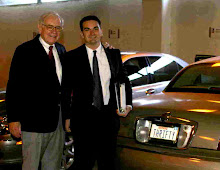Expectations Investing
“It is an appreciation for all things that make a good business, not just the financials. Warren Buffett has been the best at allowing us to understand what makes up a good business.”
Here is what I meant, said far more eloquently:
Warren Buffett has a unique ability to assess a business holistically, or on an integrated functions basis. This allows him to recognize attributes and/or assets that may have been overlooked by Wall Street, where analysts are often more concerned with short-term trends or earnings announcements than with underlying business economics.
My point is that a stock represents a share of ownership in a business, not merely a security that trades on a large national market. Thus, there are many things that happen outside of the stock market that affect the stock’s value. Some people ought to be saying right now, “Well duh.” -- I never said this was rocket science.
I recently read a fantastic book describing an investment strategy that embraces this attitude while preserving a structured and disciplined approach to stockpicking. It would be perfect for the investor not confident enough in his own intuition about the future of individual companies to focus on only a few businesses, perhaps for the “know-nothing” investor that Mr. Buffett has referred to.
The book is called Expectations Investing and was written several years ago by two academics, Alfred Rappaport and Michael Mauboussin, and published by Harvard Business School Press. I should point out that I was not asked to review this book by anyone nor do I have any interest in the book’s success. I just bring it up because I liked it.
The book begins by making the assumption that outguessing the market is too difficult. A better method by which to make decisions uses the information provided by the market to infer expectations and then judges the reasonableness of those expectations. I think of it as a bottom-up-bottom-up approach. Not only are we analyzing the company on a fundamental basis first, but we are actually using the current price of the stock to read the market’s expectations for how those fundamentals will change.
For instance, a few months ago I blogged that although I do not know if Google is overvalued or undervalued, an investor in the company ought to be aware of what its current stock price implies. Namely, that at $700/share, the expectations of the market implied by this price are that Google will eventually become the largest company in our economy. I don’t know if that will happen or not, but that is what will need to happen lest Google’s stock will underperform.
The book describes how “value drivers” and “value factors” work to affect shareholder value. While, for example, sales growth will drive shareholder value, it is the value factors such as volume and pricing that affect sales growth. So by starting with the stock price and working backwards we can infer what the market seems to expect to happen to volume and pricing. At this point we can ask ourselves if these expectations seem reasonable and also if we should expect the market’s expectations to ever change. With a good holistic perspective of the business like that which makes Buffett so successful, we should be able to answer this question easily.
The book also makes the case that a discounted future free cash flow model is the only legitimate way to measure shareholder value. Frankly, I don’t see how anyone can argue with them on this point, but clearly many people cling to short-term metrics such as PE ratios even though such metrics incorporate only information about one period’s performance. Only future free cash flow directly affects changes shareholder value since it is this cash flow that represents the return on the shareholder’s capital investment. Of course, plenty of things indirectly affect shareholder value and these are the things about which we are trying to infer information when we employ the expectations investing methodology.
Alas, we have taken an alternative approach to answering the same question. Instead of deciding on an intrinsic value to which we will compare the current price, we infer from the current price what the market’s expectations must be in order for the current price not to exceed the intrinsic value of the business. Taking this backwards approach strikes me as much more judicious application discounted cash flow valuation because it allows us to focus on what we do know for certain (the market price) rather than what we don’t necessarily know (the intrinsic value of the business).
Although he probably has never thought of it in quite these terms, I am fairly confident this is the same type of intellectual exercise Warren Buffett engages in when making an investment decision. Nonetheless, this commonsense type of analysis does not happen very often in the market. Perhaps investors are just creatures of habit.
FD: No position in GOOG


0 Comments:
Post a Comment
<< Home